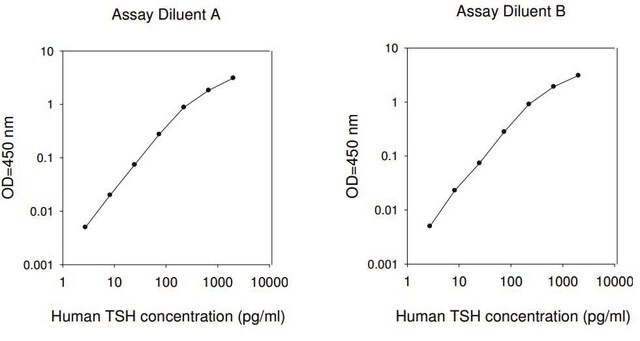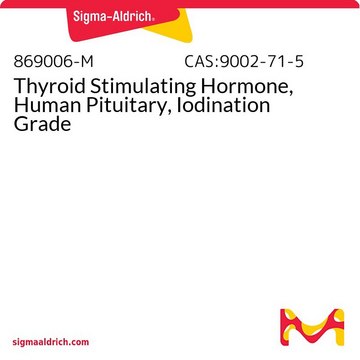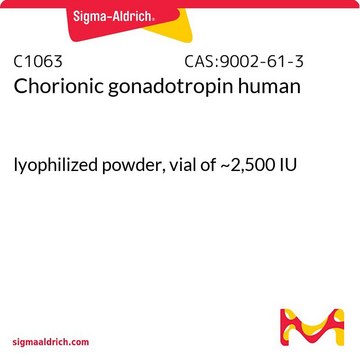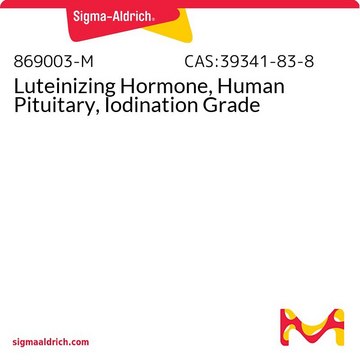F4021
Follicle Stimulating Hormone from human pituitary
~7,000 IU/mg (powder)
Sinónimos:
FSH, Follitropin
Iniciar sesiónpara Ver la Fijación de precios por contrato y de la organización
About This Item
biological source:
human pituitary glands
form:
powder
Productos recomendados
biological source
human pituitary glands
Quality Level
sterility
non-sterile
form
powder
specific activity
~7,000 IU/mg (powder)
mol wt
35 kDa
technique(s)
cell culture | mammalian: suitable
impurities
HBsAg, HCV and HIV-1/HIV-2, tested negative
pH
7.4
solubility
water: ~50 g/L
shipped in
ambient
storage temp.
−20°C
Gene Information
human ... FSHB(2488) , FSHR(2492)
General description
The α chain of FSH has 89 amino acids and the β chain has 115 amino acids. The α chain is not active. FSH belongs to glycoprotein hormone family. It is secreted by the gonadotropic cells of pituitary gland.
Research area: Cell signaling
Research area: Cell signaling
Application
Follicle stimulating hormone (FSH) from human pituitary has been used for-
- in vitro luteinization of Macaque granulosa cells
- luteal cell proliferation assay
- culturing of preantral follicle cells obtained from mice
- in vitro maturation of immature cumulus-oocyte complexes (COCs) obtained from mice and
- culture of RAW264.7 cell line
Biochem/physiol Actions
FSH (follicle stimulating hormone) in involved in the growth of ovarian follicles and steroidogenesis of ovaries. FSHR (follicle-stimulating hormone receptor) interacts with FSH in the ovaries and determines the responsiveness to this hormone. Depressed levels of FSHR result in poor responsiveness and influence folliculogenesis. In the Caucasian population, certain polymorphisms in the FSHR gene are more commonly found in patients with polycystic ovary syndrome (PCOS). In the male fetuses and neonates, it facilitates the proliferation of Sertoli cells. In pubescent males, it stimulates spermatogonia to undergo mitosis.FSH upon binding to its receptor FSH-R positively regulates G-protein coupled receptors/cyclic adenosine monophosphate (cAMP)/protein kinase A pathways to cascade intracellular signals.
The α-chain is not active; biological specificity is attributed to the β-chain. Induces maturation of Graafian follicles of the ovary; promotes development of germinal cells in males; activates cytosolic tyrosine kinase.
Packaging
Package size based on protein content
Other Notes
Two-chain glycoprotein hormone
Quality
Vial also contains 0.1 mg of salts from 0.05 M phosphate buffer, pH 7.4.
antibody
Referencia del producto
Descripción
Precios
Storage Class
11 - Combustible Solids
wgk_germany
WGK 3
flash_point_f
Not applicable
flash_point_c
Not applicable
Elija entre una de las versiones más recientes:
¿Ya tiene este producto?
Encuentre la documentación para los productos que ha comprado recientemente en la Biblioteca de documentos.
J Wu et al.
Biology of reproduction, 63(1), 320-327 (2000-06-22)
Although it is known that LH receptors are present from the time of thecal differentiation, the role of LH during early follicle development is not yet clear. The effect of LH on preantral follicle development has therefore been investigated in
Yihui Zhang et al.
PloS one, 9(6), e99393-e99393 (2014-06-17)
Anti-mullerian hormone (AMH) is thought to reflect the growth of follicles and the ovarian function. However, the role of AMH in culture medium during in vitro maturation (IVM) on oocyte quality and subsequent development potential is unclear. The objective of
Karenne N Fru et al.
Biology of reproduction, 75(4), 568-574 (2006-07-14)
Ovulation and luteal formation in primates are associated with the sustained synthesis of progesterone. The observed high intrafollicular concentrations of progesterone during the periovulatory interval raise the possibility that this steroid serves as a precursor for mineralocorticoids. The aim of
Y Figenschau et al.
Human reproduction (Oxford, England), 12(3), 523-531 (1997-03-01)
A simplified method for the preparation and long-term cultivation of granulosa-luteal cells in serum-free medium is described. The cells were harvested from women undergoing in-vitro fertilization, enriched by sedimentation and dissociated by enzymatic treatment. We demonstrated, by introducing a synthetic
Follicle stimulating hormone is required for ovarian follicle maturation but not male fertility
Kumar TR, et al.
Nature Genetics, 15(2), 201-201 (1997)
Nuestro equipo de científicos tiene experiencia en todas las áreas de investigación: Ciencias de la vida, Ciencia de los materiales, Síntesis química, Cromatografía, Analítica y muchas otras.
Póngase en contacto con el Servicio técnico








